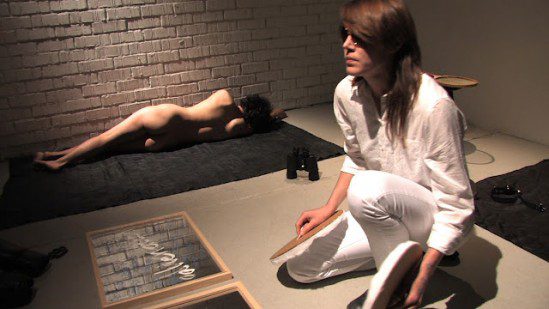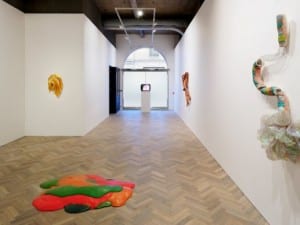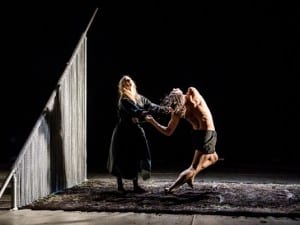Text by Bethany Rex
How do ideas of nihilism, darkness, subjectivity and abjection play out in experimental music, performance art, supernatural horror; in neuroscience or philosophy? Or: how can you trust what you think or feel? A Special Form of Darkness is an open, convivial music/performance/ideas hybrid – a cross between a festival, magazine and discussion.
Taking place from 24 – 26 February at Tramway, Glasgow, the full programme includes; Keiji Haino, Junko, Walter Marchetti, Deflag Haemorrhage/Haien Kontra, Taku Unami, Malin Arnell, Iain Campbell F-W, Dawn Kasper, Ray Brassier, Mark Fisher, Alexi Kukuljevic, Thomas Metzinger, Eugene Thacker and Evan Calder Williams. We caught up with Malin Arnell to find out more about Rehearsal after Reflect Soft Matte Discourse which will take place on Saturday 25th February.
BR: Could you give us Rehearsal after Reflect Soft Matte Discourse in a nutshell? What was the idea behind this re-enactment?
MA: In the earlier action Reflect Soft Matte Discourse, which I performed in May 2010, the idea was to re-enact and to understand Gina Panes action Discours mou et mat from 1975. With this action I wanted to test my own bodily limits and deal with some questions around intimacy, authenticity and pain. It is a discussion of the intimate body within different systems of control. It is an action that counteracts alienation trough its effort, exhaustion, and wounds.
After that experience I felt a strong need to continue my dialogue with that action and to explore and process my and my fellow performer Clara López feelings and reactions during and after the performance. Another aspect I wanted to include in the process was the reactions within the audience during the re-enactment – speaking out my name while trying to stop me from cutting my upper lip, and the absolute silence after the performance, when no applauds could be heard. I needed to take a step back and rehearse the piece that I never rehearsed, and to bring in Imri Sandström and Clara López to make it happen.
BR: In the introduction to the piece, you state that it’s an “allegorical performance of alienation, abjection and the female figure, of the extreme fragility of the body and the reality of suffering.” Why do you feel the need to self-wound in order to convey this message?
MA: The question of self-wounds is difficult. I don’t think I felt the specific need to self-wound, instead my interest was to experience the “action” from within, putting the score into practice again. Self-wound is just one aspect of the action. Today the reading or understanding of female self-inflicted wounds has a totally different implication than in 1975, I think. Today the mediatisation of self-harm and self-injury among young adulthood persons, mostly women, gives the act another framework than the one it had in 1975. Pane was strongly influenced by the psychoanalytic discourse in France, Jacques Lacan and the feminist writings by for example Hélène Cixious (écrritude feminine – female figure), she was also connected in some way to the art sociologique movement and took on the theories that Guy Debord and the Internatinale Situationniste was putting forward (alienation) and she showed her solidarity to the anti Vietnam War movement (fragility of the body and the reality of suffering). During this time Panes was using her own body as the medium through which to address socio-political issues on a collective plane. She understood the wound as “an establishment of a relationship with the other”. Her self-inflicted wounds were motivated by her desire to promote an idea of the body as a communal entity. For her, the presence and intensity that self-inflicted wounds entail were conditions for a collective de-anesthetisation.
BR: How has being a feminist affected your art – do you find yourself consciously trying to break down barriers, or can you separate being a feminist from being an artist?
MA: No, there is no way I can separate the fact of being a feminist and an artist and I don’t try to, but I mean there are other things I think that affect my life and my art practice even more – the fact that I/ we live in a capitalist society, that is inherently racist, sexist, patriarchal, heteronormative.
I don’t think braking down barriers has been the most important activity within the feminist movement/s – breaking barriers is just one method among others to open up for experiences of that something else is possible.
BR: Do you think that mainstream art will always be controlled by men and the male gaze, or are we experiencing a shift towards equality?
MA: Unfortunately I don’t see a shift coming. I just see backlash after backlash around me. And that is not just a question about men and their gaze. The global inequalities are produced by racial, class, gender, sexual, religious, pedagogical, linguistic, aesthetic, ecological and epistemological power hierarchies that operate in complex and entangled ways at a world-scale. And above all, the economic neoliberal policies are spreading its value system over every aspect of life and human and non-human relationships. I say: No equality without solidarity, and sometimes when I’m in a good mood I say: fuck the mainstream.
BR: Could you expand on what you mean by being political through being personal?
MA: I’m very confused about the use of the personal as if there are another way of being in the world that is not personal or the assumption that the personal always imply that there is a human subject with a specific identity that have the possibility to be personal, or there is also this implication that if you speak up from a minority position its personal, but if you speak from a privilege position you speak the universal facts. Used without questioning the understanding of what ideological foundation “the personal” or “the subject” are leaning on, the concept can work against itself. When Carol Hanisch put forward the concept “the personal is political” in a text written 1969, it was a respond to a criticism of women getting together in consciousness-raising groups to discuss their own oppression as “naval-gazing” and “personal therapy”— and certainly “not political.” This criticism came from many people within the radical movements of Civil Rights, Anti-Vietnam War, and Old and New Left groups. At this time the need to recognize and fight male supremacy as a movement was put forward in order to stop blaming the individual woman for her oppression. I think the important point today is to understand how to use “the personal” as a collective force that gives us agency to act and speak.
BR: Which other artists inspire you?
MA: At the moment I have this intense and fruitful love relationship with Gina Pane. I find her poetics distinctive and her writings and working methods fractiously inspiring. Of course I could list a hundred names here but I will save that for later…
BR: What advise would you give to female artists who are just starting out?
MA: Listen, learn and laugh together and don’t forget to make love to each other in all possible and impossible ways.
Episode 2: A Special Form of Darkness, 24/02/2012 – 26/02/2012, Tramway, Glasgow. www.arika.org.uk
The full programme is available now at arika.org.uk
For tickets please click here.
Aesthetica in Print
If you only read Aesthetica online, you’re missing out. The February/March issue of Aesthetica is out now and offers a diverse range of features from an examination of the diversity and complexity of art produced during the tumultuous decade of the 1980s in Art, Love & Politics in the 1980s, opening 11 February at MCA Chiacgo, a photographic presentation of the Irish Museum of Modern Art‘s latest opening, Conversations: Photography from the Bank of America Collection. Plus, we recount the story of British design in relation to a comprehensive exhibition opening this spring at the V&A.
If you would like to buy this issue, you can search for your nearest stockist here. Better yet call +44 (0) 1904 629 137 or visit the website to subscribe to Aesthetica for a year and save 20% on the printed magazine.





